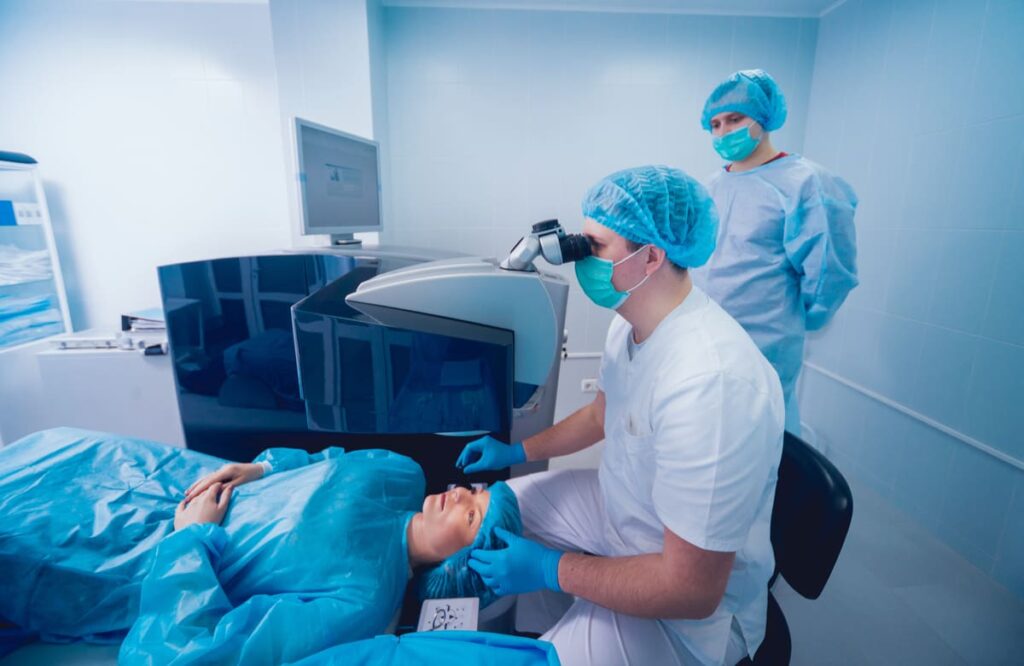LASIK surgery is a popular procedure that has helped millions of people achieve clear vision without the need for glasses or contact lenses. If you are considering LASIK surgery, it is important to understand what to expect during and after the procedure to make an informed decision. In this article, we will walk you through the entire LASIK surgery process, from understanding the basics to the long-term expectations.
Understanding LASIK Surgery
A common question many people have is, “What exactly is LASIK surgery?” LASIK stands for Laser-Assisted In Situ Keratomileusis, and it is a surgical procedure that corrects common vision problems such as nearsightedness, farsightedness, and astigmatism. During the procedure, a laser is used to reshape the cornea, the transparent, dome-shaped surface of the eye, to improve the way light enters the eye and focuses on the retina.
LASIK surgery has become a popular choice for individuals seeking permanent vision correction due to its high success rate and short recovery time. However, not everyone is a suitable candidate for LASIK surgery, and it is important to determine if you meet certain criteria before proceeding with the procedure.
The Basics of LASIK
In a LASIK procedure, the surgeon creates a thin flap on the surface of the cornea, which is then lifted to expose the underlying corneal tissue. The excimer laser is then used to precisely remove a predetermined amount of corneal tissue, based on the unique characteristics of your eyes and the desired degree of vision correction.
Once the corneal tissue has been reshaped, the flap is repositioned and left to heal naturally. The entire process typically takes less than 30 minutes per eye, and the effects of LASIK are usually immediate, with many individuals experiencing improved vision right after the surgery.

Who is a Suitable Candidate for LASIK?
While LASIK surgery has a high success rate, not everyone is an ideal candidate. You may be a suitable candidate for LASIK if you meet the following criteria:
- You are at least 18 years old.
- You have a stable prescription, with no significant changes over the past year.
- You have healthy eyes, free from eye diseases or conditions such as glaucoma, cataracts, or keratoconus.
- You have a sufficient corneal thickness to undergo the procedure safely.
- You have realistic expectations about the outcomes of LASIK surgery.
It is important to consult with a qualified ophthalmologist to determine if LASIK surgery is suitable for you. During the initial consultation, the surgeon will perform a thorough eye examination to evaluate your candidacy and discuss any potential risks or complications.
One of the key advantages of LASIK surgery is the short recovery time associated with the procedure. Most patients experience improved vision within 24 to 48 hours after the surgery. However, it is important to note that everyone’s healing process is unique, and some individuals may experience temporary side effects such as dry eyes, glare, or halos around lights. These side effects usually subside within a few weeks as the eyes continue to heal.
Furthermore, it is worth mentioning that LASIK surgery is a safe and effective procedure, but like any surgical intervention, it does carry some risks. While complications are rare, they can include infection, corneal flap complications, or undercorrection or overcorrection of vision. It is crucial to discuss these potential risks with your ophthalmologist during the consultation to make an informed decision about undergoing LASIK surgery. Click here to Read more about infections.
Preparing for LASIK Surgery
Once you have made the life-changing decision to proceed with LASIK surgery, you are embarking on a journey towards clearer vision and freedom from glasses or contact lenses. But before you take that leap, there are a few essential steps you need to take to prepare for the procedure.
Initial Consultation and Eye Examination
The first step on your LASIK journey is to schedule an initial consultation with your skilled and experienced surgeon. This consultation is a crucial opportunity for your surgeon to get to know you and evaluate your eye health. During this comprehensive eye examination, your surgeon will assess various factors to determine if you meet the necessary criteria for LASIK surgery.
Be prepared to share your medical history, including any previous eye conditions or surgeries, as well as your current medications. This valuable information will enable your surgeon to evaluate your suitability for LASIK and make an informed recommendation tailored to your unique needs and circumstances.
What to Do the Day Before Surgery
The day before your LASIK surgery is an important time to prepare yourself physically and mentally for the procedure that will transform your vision. To ensure optimal results, here are some guidelines to follow:
- Avoid wearing contact lenses for the specified period recommended by your surgeon. Contact lenses can alter the shape of your cornea, which may affect the accuracy of the LASIK procedure. Embrace the freedom of glasses for a little while as you eagerly anticipate the freedom from both glasses and contacts that LASIK will bring.
- Take a moment to pamper yourself and clean your face thoroughly, paying special attention to the eye area. Avoid using creams, lotions, or makeup on your face on the day of surgery. By keeping your face fresh and free from any potential irritants, you are setting the stage for a smooth and comfortable LASIK experience.
- Dress comfortably on the day of surgery, choosing loose-fitting clothing that allows you to relax. Avoid wearing any accessories or jewelry on your face or head, as they may interfere with the surgical process. Let simplicity be your style as you embark on this transformative journey towards visual freedom.
- Lastly, make arrangements for transportation to and from the surgical center. After the LASIK procedure, your vision may be temporarily blurred, and you will not be able to drive immediately. Ensure that you have a trusted friend or family member by your side to accompany you on this exciting day.
By following these guidelines, you are taking proactive steps to ensure a smoother and more successful LASIK surgery. Remember, this is a significant investment in your vision and quality of life, so take the time to prepare yourself physically and mentally. Soon, you will be able to bid farewell to the hassles of glasses and contact lenses, and welcome a world of clarity and freedom.
The LASIK Surgery Procedure
The LASIK surgery process consists of several steps, all aimed at providing you with clear, improved vision. Let’s break down the procedure:
Step-by-Step Breakdown of the Procedure
1. Anesthetic Drops: Before the procedure begins, your surgeon will use anesthetic eye drops to numb the surface of your eyes. This helps minimize any discomfort during the surgery.
2. Creation of the Flap: Using a microkeratome or a femtosecond laser, the surgeon creates a thin, hinged flap on the cornea. This flap is then gently lifted to expose the underlying corneal tissue.
3. Corneal Reshaping: The excimer laser is used to remove a precise amount of corneal tissue, following the planned treatment parameters. The laser emits cool pulses of light that reshape the cornea, correcting the refractive errors and improving the focusing power of the eye.
4. Flap Repositioning: Once the corneal reshaping is complete, the surgeon carefully repositions the flap back into its original position. The flap adheres naturally, without the need for stitches. The self-sealing nature of the cornea allows for quicker healing and reduced discomfort.
Each eye is treated separately, with a short interval between the procedures. The surgeon will determine the most suitable approach based on your individual eye characteristics and needs.
Duration and Pain Management
The actual LASIK surgery typically takes less than 30 minutes to perform, with each eye taking only a few minutes. The entire process is painless, thanks to the anesthetic eye drops used prior to the procedure. Some individuals may experience slight pressure or a sensation of mild discomfort during the surgery, but this is usually temporary and subsides quickly.
After the surgery, your eyes may feel slightly dry or irritated, but any discomfort can usually be managed with the prescribed eyedrops or over-the-counter artificial tears. It is essential to follow your surgeon’s instructions regarding post-operative care to ensure optimal healing.

Post-Surgery Experience
After LASIK surgery, it is normal to experience some degree of immediate improvement in your vision. However, your eyes will continue to heal and adjust in the days and weeks following the procedure. Let’s take a closer look at what you can expect during the post-surgery period.
Immediate Aftercare and Recovery
Following the surgery, you will be provided with specific aftercare instructions by your surgeon. These instructions may include:
- Avoiding rubbing your eyes for a certain period to prevent dislodging the corneal flap.
- Using prescribed eyedrops to aid healing and prevent infection.
- Wearing protective eye shields or goggles while sleeping to avoid accidental eye rubbing.
- Avoiding strenuous activities and contact sports for a few weeks.
It is important to attend all scheduled follow-up appointments to monitor your progress and address any concerns or questions you may have during the recovery period. Read more about protective eye shields at https://case.edu/ehs/laboratory-safety/personal-protective-equipment/eye-protection
Potential Side Effects and Complications
While LASIK surgery is generally safe and provides excellent results, it is essential to be aware of potential side effects and complications. Some individuals may experience temporary side effects, such as dry eyes, glare, halos around lights, or nighttime vision disturbances. These usually resolve over time as your eyes heal.
Serious complications are rare but can include infection, corneal flap complications, corneal thinning or irregularities, or changes in vision. It is crucial to follow your surgeon’s instructions carefully and report any unusual symptoms or concerns promptly.
Long-Term Expectations After LASIK Surgery
After LASIK surgery, many individuals enjoy long-term improvements in their vision, reducing their dependence on glasses or contact lenses. However, it is important to understand that your eyes may still change over time, especially as you age. Let’s take a look at what you can expect in the long term.
Vision Improvement Timeline
The majority of individuals experience an immediate improvement in their vision following LASIK surgery. It is not uncommon to achieve 20/20 or better vision within a few days or weeks. However, it is essential to note that visual recovery can vary between individuals.
In rare cases, some patients may require an enhancement or “touch-up” procedure to further refine their vision. This is typically performed several months after the initial surgery, once the eyes have stabilized. Your surgeon will monitor your progress during follow-up appointments and determine if an enhancement is necessary.
Follow-up Appointments and Ongoing Care
Regular follow-up appointments are an essential part of the LASIK surgery process. During these appointments, your surgeon will assess your vision and overall eye health, ensuring that your eyes are healing properly and any necessary adjustments are made.
Even after your eyes have stabilized, it is important to continue practicing good eye care habits and attend routine eye exams to maintain your vision and overall eye health. Your surgeon may provide specific recommendations based on your individual needs.
By understanding the LASIK surgery process and knowing what to expect during and after the procedure, you can make an informed decision and have realistic expectations. Whether you are seeking freedom from glasses or contact lenses or simply want to regain clear vision, LASIK surgery has helped countless individuals achieve their visual goals. Consult with a qualified eye surgeon to determine if LASIK is right for you and embark on the journey to clearer vision!



